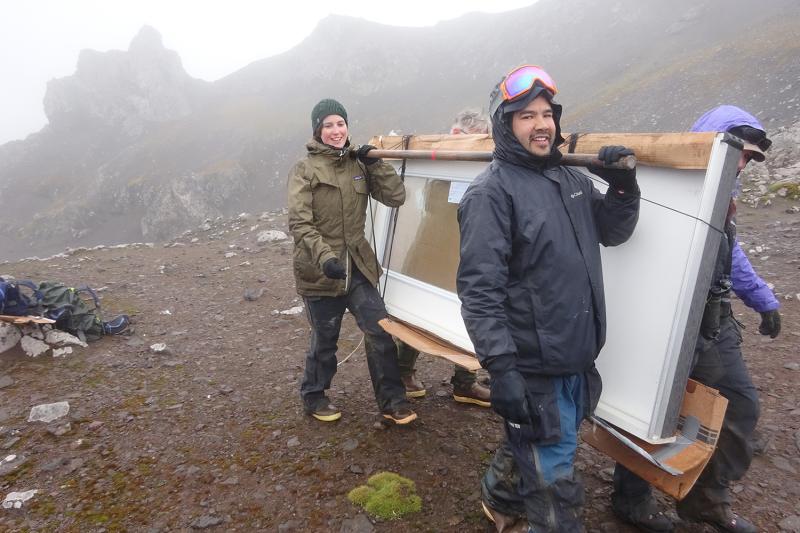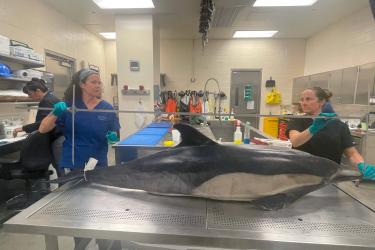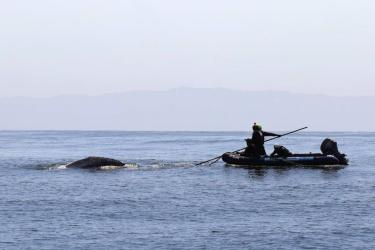Tiny but Mighty
Cape Shirreff was built in an “Antarctic Specially Protected Area” designated by the Antarctic Treaty. Because its location has high environmental value, the camp was built on the condition that it remain “temporary,” and could be removed entirely from the island without significant impacts to the surrounding ecosystem.
The temporary nature of the camp limited both its footprint and the materials that could be used to construct it. Next to larger Antarctic field stations, it resembles more of a backyard shed than a home base for scientists. In comparison, McMurdo Station–the United States’ largest, with a footprint of nearly half a square mile–is a science logistics hub for research projects in remote areas of the continent. It comprises more than 85 buildings and employs hundreds of staff to support year-round science. Cape Shirreff has a footprint of approximately 1,200 square feet, and is home to four to six scientists for 3 to 5 months every year. There are no tractors or helicopters that deliver scientists and their gear to other parts of the island. There’s one all-terrain vehicle, used only when camp is opened and closed to bring supplies between the landing beach and the buildings. There are no support staff. The scientists are also the cooks, cleaners, maintenance workers, and emergency response providers.
“Having to do the science and the life stuff while I’m at Cape Shirreff deepens the connection both to the camp and to the experience. It’s a more complete, holistic experience,” said NOAA Research Biologist Sam Woodman. This season was Woodman’s fourth at Cape Shirreff, after a 4-year gap between his second and third seasons. “After not being there for 4 years and then coming back, it immediately felt like being home again because the experience is so immersive.”
Despite its small size and lack of infrastructure, Cape Shirreff is the lifeblood of NOAA’s land-based research in Antarctica. The site has become a science powerhouse, generating several multi-decadal time series of data on the reproductive success and population trends of Antarctic fur seals and two species of penguins. For more than two decades, these data have been used by the Commission for the Conservation of Antarctic Marine Living Resources—the international organization that manages and protects Antarctic marine life. Research at Cape Shirreff has contributed to policy decisions that have life-or-death consequences for the Antarctic predators that rely on a healthy ecosystem to survive.
Early Science at Cape Shirreff
From 1996 to 2011, land-based research at Cape Shirreff coincided with the our oceanographic krill surveys during the austral summer. The goal of the surveys each year was to estimate the amount of krill available to predators—seals and penguins—that raise their young on land, but make regular trips to sea to eat. These surveys were crucial to the Commission for the Conservation of Antarctic Marine Living Resources’s management of the growing krill fishery to ensure enough krill remained for predators.
For the first few years of the camp’s existence, our ocean- and land-based research teams worked together to conduct several studies right off the coast of Cape Shirreff. They tried to better understand how much krill was available to predators in nearshore areas that were too shallow for a large research vessel.
In 2000, David Demer—head of the program’s acoustic research at the time—and field biologist Adam Jenkins designed a small, nearshore survey vessel named the R/V Ernest. The Ernest conducted coastal surveys from 2000 to 2006 and was equipped with multiple sensors and instruments. It measured ocean conditions and the amount of krill close to breeding beaches, where fur seals and penguins were likely to forage.
Researchers transported the Ernest to and from Antarctica each field season aboard the R/V Yuzhmorgeologiya. The program chartered this large research vessel for its annual offshore krill survey. During the field season, the Ernest was moored at Cape Shirreff each night. “We slept and ate meals with the camp field team and enjoyed the cooking and ribbing of our fearless leader Rennie Holt,” said Jenkins. “In addition, we had a chance to go out with camp leaders Dr. Mike Goebel and Dr. Wayne Trivelpiece, who were doing the land-based seal and seabird studies. The time I spent at Cape Shirreff from 2000 to 2003 were memories I hold dear to my heart.”
“Each year, the oceanographic team provisioned, maintained, and refined the Cape Shirreff field camp,” said Demer. “The scientists who mainly worked aboard the ship enjoyed opportunities to visit the camps, even if it was just to help remove equipment and trash and close the camp.”
Home Improvement, Antarctic Version
Since 2007, research at Cape Shirreff has been focused on Livingston Island and the nearby San Telmo Islets. Scientists work 12 hours or more per day, 7 days a week, and sometimes hike more than 10 miles each day to distant fur seal rookeries and penguin colonies. They meticulously counted animals and nests, monitored the development of fur seal pups and penguin chicks, and observed behavior that might reveal the health of these populations of animals.
While science has always been the main goal of Cape Shirreff, maintenance has always been a close second for those at the camp. Each year at camp closing, scientists thoroughly inventory everything that needs repair. Staff will later purchase the necessary supplies back in the U.S. and ship them to the camp for the next field season. If they forget something, or discover an unexpected problem when opening the camp, scientists often have to improvise.
“One good memory was Day One of the 2015–2016 field season. We had to replace the doorknob before we could even open camp because we couldn’t open the front door. A little team-building exercise right off the bat!” said field biologist Tony Kroeger.
"The 2021–2022 field season was special,” said NOAA Corps Officer David Wang. “The camp had not been occupied for more than 2 years because of COVID-19 and we were there for just under a month. This called for some creative repair jobs, specifically a deck repair with a spare crate that also doubled as a convenient step."
Sometimes, a repair is simply botched.
“In 2011, we had to replace an aging and rusted metal door on our emergency shelter out near the penguin colonies,” said Jefferson Hinke, the current Program Lead of Seabird Research for the program. “A team of four hand-carried the replacement door a mile from the main hut to the shelter, and I eagerly started demolition of the old door. Only once the gaping hole in the shelter was open did I discover that the frame around the replacement door was too big. After a rapid assessment of the measurements (which I probably should have done first), available tools, and the rapidly closing window of good weather, I was determined to customize the new frame with our dull saw and I cut off the entire footer of it. With a bit of luck, the hack job on the new door frame worked and I was able to set the door in its jam, replace the trim, and shut the door without an aggressive hip check. Whether good or not, the replacement lasted nearly a decade.”
Not all maintenance involves repairs. Most years, the scientists first have to dig the camp out of a winter’s worth of snow to open it. Snow shoveling is a constant task throughout the field season, and often leads to some good-natured (though strategic) competition among scientists.
Especially when it comes to the outhouse.
“I always remember springtime, when it seemed like every night the snow would drift in up to the door knob on the back door of the camp, all the way to the outhouse,” said field biologist Ryan Burner. “The person who needed the outhouse earliest would end up shoveling their way there every day. I think the rest of us just laid in bed hoping someone else would be first.”
“It always seemed like we were all playing a silent game of chicken with each other, seeing who could wait the longest and still be able to dig out the outhouse to use it,” said field biologist Kevin Pietrzak.










